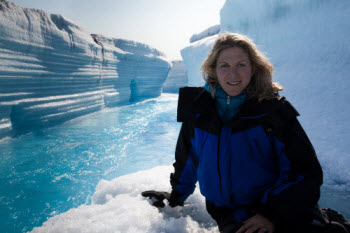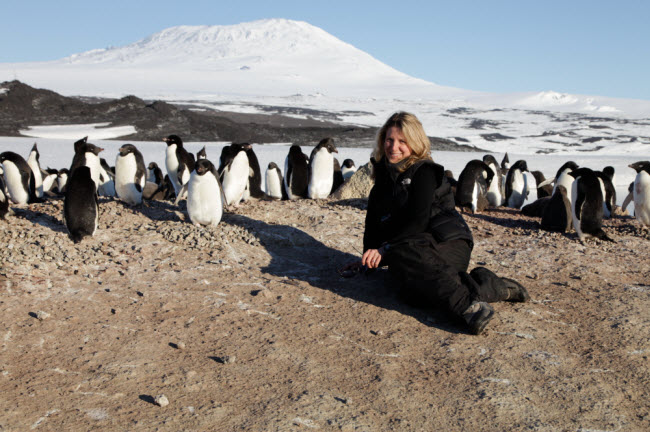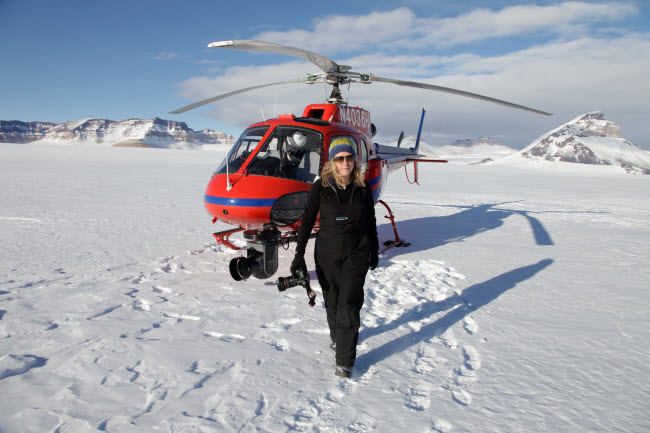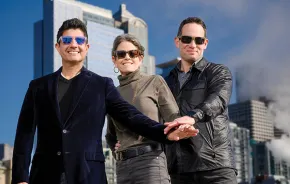 Whether they live in Honolulu or Honduras, work as ER nurses or abstract artists, moms face a lot of the same day-to-day challenges. Just ask Vanessa Berlowitz. The director and producer of the upcoming Discovery Channel documentary series Frozen Planet has spent years shooting and developing footage of the remotest areas of the planet, the Arctic and Antarctic wilderness. While pregnant, Berlowitz has filmed polar bears, braved temperatures so cold cameras were freezing over, and was almost sucked into a waterfall while trying to get a shot — but this down-to-earth explorer insists she’s just like most moms.
Whether they live in Honolulu or Honduras, work as ER nurses or abstract artists, moms face a lot of the same day-to-day challenges. Just ask Vanessa Berlowitz. The director and producer of the upcoming Discovery Channel documentary series Frozen Planet has spent years shooting and developing footage of the remotest areas of the planet, the Arctic and Antarctic wilderness. While pregnant, Berlowitz has filmed polar bears, braved temperatures so cold cameras were freezing over, and was almost sucked into a waterfall while trying to get a shot — but this down-to-earth explorer insists she’s just like most moms.
“I was just getting on and doing my job,” Berlowitz says. “I guess the only difference is that mine is a little more extreme than most people's jobs.”
We caught up with Berlowitz to ask about her experiences filming in the polar regions, the best parts of her job, and how she juggles her unique work and family life. Find out more when Discovery Channel’s Frozen Planet debuts March 18 at 8 p.m. EST.
Let's start with the basics! How many kids do you have? Where's home? And what does your family think of what you do?
I have one son named Cameron. We call him Cammie — he's three years, four months old. My husband, Mark Linfield, was also one of the producer-directors on Frozen Planet. We worked together on Planet Earth and Life before that. He's pretty cool about what I do, as he does it, too! We live in a place called Bristol, two hours west of London. I have been working for the past 22 years for the BBC Natural History Unit, which is based in Bristol.
Where exactly did you film for Frozen Planet?
We filmed in the Canada/Russia/Norwegian Arctic, as well as Greenland and Alaska. In Antarctica, we filmed on the Antarctic Peninsula and also around McMurdo Base on the Ross Sea. We filmed at both poles.
Share your experiences in the Arctic and Antarctic while filming the documentary — what did you film and how long were you there?
The team filmed for a combined 2,356 days in the field. Personally, I spent about eight months in the polar regions, which included filming mother polar bears with very young cubs in the Norwegian Arctic. I was five months pregnant at that time. I also filmed thousands of white beluga whales meeting in the Canadian Arctic. I spent five weeks in Greenland filming aerials of the ice sheet, as well as scientists exploring dynamic melt-water lakes and giant waterfalls — which actually plummet into the ice sheet. I spent two-and-a-half months in Antarctica running our biggest mega-shoot. We had seven crews all based out of McMurdo base, supported by the National Science Foundation for up to five months. I was also directing all the aerials while down there, both on helicopters and also on planes. I filmed with Sir David Attenborough at the North and South Poles, and also spent time with him filming in the Norwegian Arctic.
What were your goals for the project?
The main goal of the project was to present the ultimate portrait of the Polar Regions before they change forever. The Arctic and Antarctic are warming two times — and in some places five times — as fast as the rest of the planet. We felt a moral imperative to turn our attention to these regions now. I had also produced the “Ice Worlds” and “Mountains” episodes of Planet Earth, so was aware that there was still so much to be filmed in these places — not just staggering scenery, much of which hasn’t been seen by humans, let alone filmed — but also charismatic animals, and some of the largest wildlife spectacles on earth. What's more, these regions experience the most dramatic natural drama on the planet. They have the most extreme seasonal change, going from total darkness for up to half the year in winter, to 24-hour daylight in the summertime.
What did you hope the audience would take away from the documentary?
We wanted the audience to experience this type of extraordinary change through the eyes of the animals that have to survive through this. They literally see their world go from being cloaked in ice and darkness to being full of life and color and light. In this short window, they must find a mate, breed, and raise their young. We wanted people to feel the admiration we do for the animals that survive at the outermost extremes of our planet. They really are the ultimate survivors. My hope is that the audience will become so enamored with these amazing places and incredible animals that they will want to learn more about the poles and hopefully strive to protect them.
What was it like to see wildlife up close, like your three weeks with the polar bears?
I will never forget my time watching polar bears with such tiny cubs [in the Arctic] — they were only a couple of months old. It's really unusual to be able to spend so much time with a mother and such a young family, as she would normally be extremely wary and would run at the first sniff of a film crew on the ground. Filming from the air is another story. We used the same aerial camera, the Cineflex, which was pioneered on Planet Earth, to film them from a helicopter. This meant we could stay a mile above her and downwind. She was completely oblivious to our presence and we followed her for three days. It was truly magical.
What about the wildlife in the Antarctic? Any particularly favorite memories?
Antarctic wildlife is equally special. I loved spending time in the most southerly penguin colony on earth, in the company of Adelie penguins. They really are natural comedians — you had to keep an eye on them. One inquisitive male started rolling my camera lens down the hill and was fully intending to add it to his nest — a very big rock indeed. Another penguin decided to go to the bathroom in my camera bag, and yet another penguin tried to mate with the fluffy coated microphone that we were using to record sound!

I have also been lucky enough to hover about 100 feet above humpback whales as they dived in teams to catch their dinner. I was leaning out of the helicopter and could hear them blowing air from their blowholes. I was moved to tears to see such magnificent creatures from such an unusual perspective.
What was it like to do all this extensive filming while also pregnant?
I was five months pregnant whilst filming the mother polar bear and cubs. I had a full checkup before I went so wasn't too worried. Also, you have to understand that for me, going on location to remote places is like going to the office for other people. I know exactly what to expect and prepare accordingly. I did tell the key people on the shoot, and they did look after me. I wasn't allowed to carry any of the gear onto the helicopter, which I would normally be expected to do.
When we did find the polar bear family, we decided not to leave her in case we lost her, so we literally filmed for five to six hours at a time, and then alighted on the ice and slept for a few hours, and then carried on again. This definitely took its toll on my back, which was aching anyway. But it was such an amazing experience that I’d just forget the discomfort. I also learned good mothering tips from the polar bear mom, who would periodically give her naughty little cubs a timeout. I laughed so much while we were filming this, and wondered if this was what I would have in store.
What was the most difficult footage to get?
Wildlife filmmakers have been trying to get footage of the remarkable team tactics that orcas use to hunt seals in Antarctica. It's really hard to get this footage, because you don't know where to find them in the vast Southern Ocean. It's also really dangerous working among the pack ice where they live, as the giant blocks of ice move constantly and can crush a normal boat like a tin can. We used a special ice-strengthened yacht and invited two orca scientists onboard. They satellite-tagged a pod so that we could follow them day and night. In order to be able to keep up, we had two skippers on board who could sail ‘round the clock. What's more, we took our aerial camera, flipped it upside down and stuck it onto a crane on the top of the yacht so that we could get stable shots of the action on the move. The team was very brave, and took a zodiac very close to the whales so that they could get shots above and below water in the thick of the action. I am immensely proud of the team that they achieved this sequence — many scientists who have seen it have described it as the most amazing wildlife sequence that has ever been filmed.
Did you have any setbacks while filming?
Filming in the cold is an immense challenge, and we certainly had our fair share of problems. I tried to film the first aerials of the South Pole from a plane and the camera kept freezing, since it was -60 degrees Celsius (-140 degrees Fahrenheit) outside. It was very stressful, and we only just managed to get enough shots, which was very frustrating as I had been waiting for nearly two months for the weather to be clear enough to make the long flight from the base we were staying at.
Yikes! I can think of another potential setback… Your helicopter almost got sucked into a giant waterfall in the ice. What were you thinking during that time? Was there a moment when you thought you might not make it?
I wanted to get this really dramatic aerial shot going low over the water as it poured into the abyss below, so we gradually descended closer [to the waterfall] each take. On the fourth take, we were almost skimming the water's surface. You could hear the roar of the waterfall even above the noise of the helicopter, and it was deafening. I started to get vertigo as we hovered over the black hole, as I was watching the monitor and seeing the camera rotate 360 degrees, while also watching the water through the glass window beneath my feet. I sensed that we were fighting a major downdraft that seemed to be sucking us lower. I simply thought, This is it. We're going down. I wasn't particularly panicked. Just resigned. Fortunately, our Norwegian pilot was absolutely amazing and managed to pull us out just in time. Needless to say, we didn’t go back for another take...
What was the most rewarding part of your work in the Arctic and Antarctic? What makes it all worth it?
The most rewarding part of the experience is when the films go out to the audience and you get a great response. I got a fantastic, handwritten email from an Iranian girl who watched an episode, and was so inspired that women do jobs like mine, that she wants to try and follow in my footsteps. She wrote me a beautiful poem inspired by the polar bear footage she had seen — it moved me to tears. She is only 11.
How do you juggle being a mom, and being away doing your documentary work?
This is really tough. I don't travel as much as I used to — before Cammie, I would often spend eight months of the year away in the field. The other big change is that my husband and I used to try and be away at the same time so we could see more of each other. Now, we have to stagger our trips so that we always have one parent at home for our son.
Sometimes, this doesn't work out. For example, Mark was supposed to be coming back from Antarctica so that I could fly out there, but the ice-breaking ship he was on got trapped in the sea ice for ten days. I had no option but to leave my son with his nanny, as there aren’t many flights to Antarctica, so I couldn't exactly take a later flight. The next flight would have been two months later!
How did you deal with leaving him?
He was ten months old when I left him, and I was really anxious. I wrote a massive tome of instructions for Mark, and there were notes posted all over the house saying things like, “Why are you down here by the wine rack — where's Cam?!” or, on the front door I put a note saying “Stop! Make sure Cammie has his hat, scarf and gloves on!” I felt a bit like an Emperor penguin female abandoning my son to the father to look after. I was really sad to miss his first Christmas, too. Fortunately the NASA guys in Antarctica helped me Skype him on Christmas Day.
So, Dad did well?
Mark and Cammie managed brilliantly without me, although I was really upset when I got home, as Cammie seemed not to recognize me. After a week, things settled back to normal, but I must admit, that was one of the hardest weeks of my life, and I did wonder whether I could ever leave him again. It's much easier now that I can talk to him and explain what I’m doing, and when I will be home. In other ways it's much harder to leave him — he is so adorable, and gets cuter by the minute.
What advice would you give other women dealing with pregnancy or motherhood, along with a tough job or a job that puts you in difficult situations?
Don't beat yourself up too much. I had to reconcile myself to the fact that filmmaking is part of my DNA, so I knew giving up my work when I had Cam wasn't really an option. Provided you create a really loving environment around your children, I do think you can help them adapt. Pretty soon, it just becomes their normality. The hardest decisions are when I am in the field and realize that I am in a very risky situation. I feel very anxious about leaving my son without a mum, so I do try and be as cautious as possible. But it is hard when risk is inherent in your job.
What is your favorite part of motherhood? What makes it all worthwhile?
My favorite part of being a mum is seeing this extraordinary new life take shape. Cammie is so interested in everything. He watched the first show with me — the one that I produced and directed, so I was able to talk him through all the scenes: “This was what mummy was doing when she missed your first Christmas…” He was absolutely enthralled. At the end, I asked him what his favorite bit was, and he said, “The shot of mummy in the helicopter,” which was shown at the very end of the UK version of the show.
I am so proud of him, and really hope that one day he will really understand what I do, and hopefully be OK with the fact that his mummy is a bit different from some other mummies.
About Frozen Planet
From the makers of Planet Earth and Life, Frozen Planet is the ultimate portrait of our earth's polar regions, where the scale and beauty of the scenery and sheer power of the natural elements are unlike anywhere else on the planet. A co-production of Discovery Channel and the BBC, and narrated by award-winning actor Alec Baldwin, Frozen Planet premieres on Sunday, March 18, at 8 p.m.









